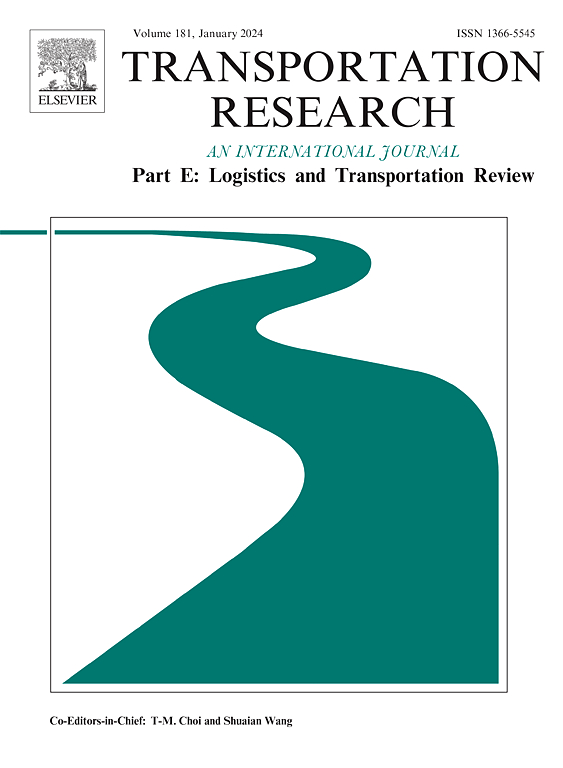Traveler time allocation between activities and travel: A computational graph-infused machine learning framework with bi-mode MDCEV model
IF 8.3
1区 工程技术
Q1 ECONOMICS
Transportation Research Part E-Logistics and Transportation Review
Pub Date : 2025-05-16
DOI:10.1016/j.tre.2025.104154
引用次数: 0
Abstract
Multiple discrete–continuous extreme value (MDCEV) model has received increasing attention in modeling travelers’ time allocation. However, the MDCEV model primarily focuses on activity choices that generate increased utility over time, overlooking the fact that travel, as a derived activity, is typically something people prefer to save time on. To bridge the research gap, we introduce the bi-mode utility multiple discrete–continuous extreme value (BMU-MDCEV) model. This model seamlessly integrates a diminishing function for travel with the classical utility function, underscoring the principle that individuals typically aim to minimize travel time. Inspired by the fact that both choice modeling and machine learning (ML) involve non-convex optimization processes, this study implements an ML-based computational graph (CG) mechanism to provide reliable and efficient parameter estimates for the proposed model. This approach emphasizes the integration of theory- and data-driven methods within the context of multiple discrete–continuous choices. Validated using the National Household Travel Survey (NHTS) 2017 dataset, the CG-enhanced BMU-MDCEV model effectively uncovers socioeconomic heterogeneity and captures the substitution and complementarity in time allocation patterns. Our analysis of the marginal utility of various travel types reveals a positive correlation between travel time tolerance and activity satiation for discretionary activities (e.g., leisure, shopping). Conversely, individuals tend to reduce unnecessary travel time for mandatory daily activities (e.g., home-based activity, work), regardless of the degree of activity satiation. By shedding light on the nuanced mechanisms behind individuals’ time allocation, our proposed method paves the way for informed transport management strategies that respond more effectively to individual behavior.
活动和旅行之间的出行者时间分配:基于双模MDCEV模型的计算图注入机器学习框架
多重离散连续极值模型(MDCEV)在行人时间分配建模中越来越受到关注。然而,MDCEV模型主要关注的是随着时间的推移产生更多效用的活动选择,而忽略了一个事实,即旅行作为一种派生活动,通常是人们更喜欢节省时间的事情。为了弥补研究空白,我们引入了双模效用多重离散连续极值(BMU-MDCEV)模型。该模型将旅行的递减函数与经典效用函数无缝地集成在一起,强调了个人通常以最小化旅行时间为目标的原则。受选择建模和机器学习(ML)都涉及非凸优化过程这一事实的启发,本研究实现了一种基于ML的计算图(CG)机制,为所提出的模型提供可靠和有效的参数估计。这种方法强调在多个离散连续选择的背景下,理论和数据驱动方法的整合。使用2017年全国家庭旅行调查(NHTS)数据集进行验证,cg增强的BMU-MDCEV模型有效地揭示了社会经济异质性,并捕获了时间分配模式的替代和互补。我们对各种旅行类型的边际效用的分析表明,旅行时间容忍度与自由支配活动(如休闲、购物)的活动满足度之间存在正相关关系。相反,个人倾向于减少不必要的旅行时间,以进行强制性的日常活动(例如,以家庭为基础的活动,工作),而不管活动满足程度如何。通过揭示个体时间分配背后的微妙机制,我们提出的方法为更有效地响应个体行为的知情交通管理策略铺平了道路。
本文章由计算机程序翻译,如有差异,请以英文原文为准。
求助全文
约1分钟内获得全文
求助全文
来源期刊
CiteScore
16.20
自引率
16.00%
发文量
285
审稿时长
62 days
期刊介绍:
Transportation Research Part E: Logistics and Transportation Review is a reputable journal that publishes high-quality articles covering a wide range of topics in the field of logistics and transportation research. The journal welcomes submissions on various subjects, including transport economics, transport infrastructure and investment appraisal, evaluation of public policies related to transportation, empirical and analytical studies of logistics management practices and performance, logistics and operations models, and logistics and supply chain management.
Part E aims to provide informative and well-researched articles that contribute to the understanding and advancement of the field. The content of the journal is complementary to other prestigious journals in transportation research, such as Transportation Research Part A: Policy and Practice, Part B: Methodological, Part C: Emerging Technologies, Part D: Transport and Environment, and Part F: Traffic Psychology and Behaviour. Together, these journals form a comprehensive and cohesive reference for current research in transportation science.

 求助内容:
求助内容: 应助结果提醒方式:
应助结果提醒方式:


